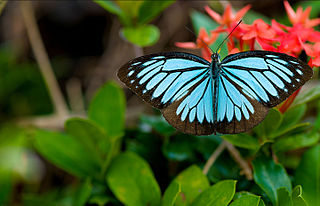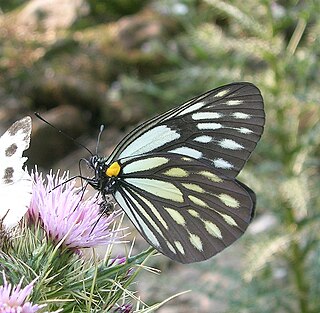
Euthalia aconthea, the common baron, often called simply baron, is a medium-sized nymphalid butterfly native to Sri Lanka, India and southeast Asia. It flies with stiff wing beats and often glides. The wing is not flapped very far below the horizontal.

Parantica aglea, commonly known as the glassy tiger, is a butterfly found in the Indomalayan realm. The species is a member of the Danainae subfamily of the Nymphalidae family.

Elymnias hypermnestra, the common palmfly, is a species of satyrine butterfly found in South and Southeast Asia.

Pareronia valeria, the common wanderer or Malayan wanderer, is a medium-sized butterfly of the family Pieridae, that is, the yellows and whites, and is found in India and Southeast Asia. The butterfly found in India is sometimes considered as a separate species, Pareronia hippia.

Papilio (Chilasa) agestor, the tawny mime, is a swallowtail butterfly, native to Indian subcontinent and widely found across Asia. The butterfly belongs to the mime subgenus, Chilasa, of the genus Papilio or the black-bodied swallowtails.

Papilio clytia, the common mime, is a swallowtail butterfly found in south and southeast Asia. The butterfly belongs to the subgenus Chilasa, the black-bodied swallowtails. It serves as an excellent example of a Batesian mimic among the Indian butterflies.

Papilio (Chilasa) epycides, the lesser mime, is a swallowtail butterfly found in India and parts of South-East Asia. The butterfly belongs to the mime (Chilasa) subgenus or the black-bodied swallowtails. It is a mimic of a common Indian Danainae, the glassy tiger butterfly.

Byasa latreillei, the rose windmill, is a butterfly from the windmills genus (Byasa), found in various parts of Asia, comprising tailed black swallowtail butterflies with white spots and red submarginal crescents.

Athyma selenophora, the staff sergeant, is a species of nymphalid butterfly found in tropical and subtropical Asia.

Aporia agathon, the great blackvein, is a mid-sized butterfly of the family Pieridae, that is, the yellows and whites, which is found in Nepal, India, China and Southeast Asia.

Parantica nilgiriensis, the Nilgiri tiger, is a butterfly found in the Western Ghats of India south of the Konkan. It belongs to the danaid group of the brush-footed butterflies family.

Castalius rosimon, the common Pierrot, is a small butterfly found in India that belongs to the lycaenids, or blues family.

Azanus jesous, the African babul blue or topaz-spotted blue, is a small butterfly found in Africa, Egypt, Syria, India, Sri Lanka and Myanmar that belongs to the lycaenids or blues family.

Chilades lajus, the lime blue, is a small butterfly found in India, Sri Lanka, Myanmar, Taiwan, Hong Kong, Hainan, Mangulam Island, Sulawesi and the Philippines that belongs to the lycaenids or blues family.

Jamides bochus, the dark cerulean, is a small butterfly found in Indomalayan realm that belongs to the lycaenids or blues family. The species was first described by Caspar Stoll in 1782.

Jamides celeno, the common cerulean, is a small butterfly found in Indomalayan realm belonging to the lycaenids or blues family. The species was first described by Pieter Cramer in 1775.

Hypolimnas misippus, the Danaid eggfly, mimic, or diadem, is a widespread species of nymphalid butterfly. It is well known for polymorphism and mimicry. Males are blackish with distinctive white spots that are fringed in blue. Females are in multiple forms that include male-like forms while others closely resemble the toxic butterflies Danaus chrysippus and Danaus plexippus.

Ideopsis vulgaris, the blue glassy tiger, is a butterfly that belongs to the crows and tigers, that is, the danaid group of the brush-footed butterflies family.

Neptis columella, the short banded sailer, is a species of nymphalid butterfly found in South and Southeast Asia.

Pareronia hippia, the common wanderer or Indian wanderer, is a medium-sized butterfly of the family Pieridae, that is, the yellows and whites. It is found in India. Some authors consider this as a subspecies of Pareronia valeria.






















